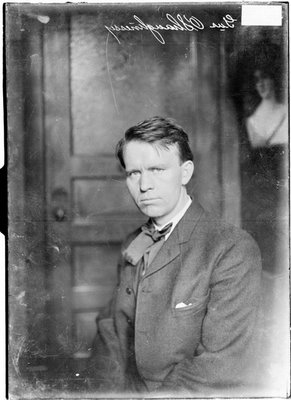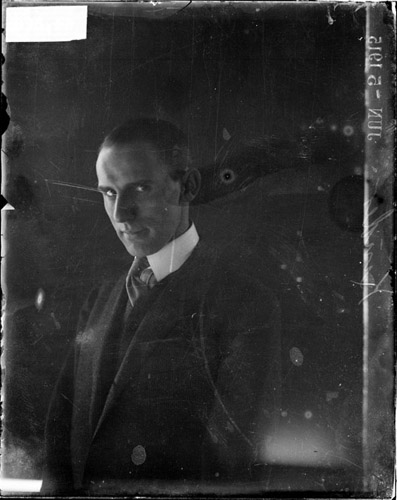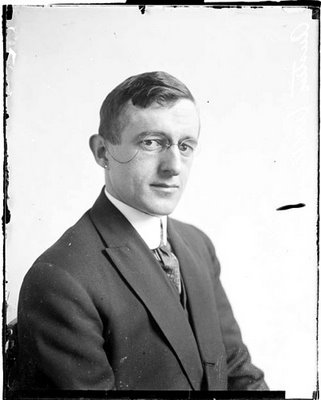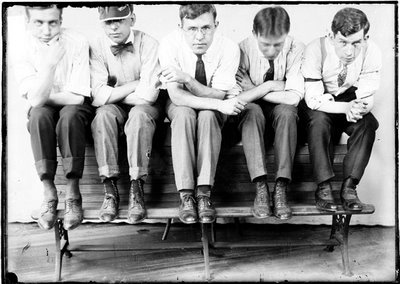Saturday, May 13, 2006
Cartoonists of the Chicago Daily News

Here's Charles F. Batchelder. I just knew he'd look like this. Just from his cartoons you could tell that he was obviously the grand old man amongst the comics page crowd right from the beginning. Not only was he amongst the most accomplished of the artists, but he was also usually responsible for the extra large panel cartoon that would often act as the central hub of the comics page:

Here's Fred Richardson. He actually predates the regular daily comics page in the Daily News. He did a full page Sunday cartoon that began in 1899 (the daily page began in 1900) and ran until 1901. I never saw him contribute to the daily page. He disappeared for 6 long years, then popped back up in 1907, once again getting a special spot for a closed-end strip commemorating something called the Jamestown Exhibit:

Here's Ted Brown. He was an absolute whirling dervish of the drawing board, producing more material for the daily pages than anyone except the great George Frink. He signed his work simply 'Ted':
Here's Pierre Kinder. He only showed up on the daily page sporadically in 1905-1906. He must have had other regular duties on the Daily News, I guess, and just moonlighted on the comics page every once in awhile. His longest running strip was Burglar Bill. Here he is doing his Dracula impression:
Here's Richard Thain. He joined the comics page crowd in 1907, and frequently subbed for George Frink on his strips. He also created the long-running Lord Longbow strip:
Here's Austin Williams. He was a Johnny-come-lately who took over The Inventor from Ted Brown at the tail end of its run in 1917. His only other known credit is Red and Skeeter, which ran for a short while in 1915 on the Saturday kids page:

Now here's a mystery photo from 1907. The caption just says that these are 5 young Chicago Daily News artists:

And last but not least, here's a 1904 photo whose caption says these fellows are dressed up as comic strip characters. No doubt about it, the gents are dressed up as Drowsy Duggan and Brainy Bowers, the News' flagship comic strip characters:
Oddly enough, there are no photos of the great George Frink, who worked at the Daily News for well over a decade, nor of K.E. Garman, another comics page mainstay. Nor, for that matter, photos of some Daily News cartoonists who went on to hit it big elsewhere - R.B. Fuller, Harry Hershfield and H.T. Webster.
All photos above are from the Chicago Daily News negatives collection, courtesy of the Chicago Historical Society.
PS: this post took a lot of time to compile, and I've got to get ready for a business trip this week, so I'm not going to post on Sunday. See ya Monday!
Joe Procopio www.LostArtBooks.com
Friday, May 12, 2006
Eddie and the Umbrellas
 Some of you might have been thinking that Holtz fella was pulling your leg. Back in this blog entry, I discussed how Eddie Eksergian had a fetish for umbrellas. Well, here's a 1901 sample as proof. And I promise you, this is by no means the only one of these.
Some of you might have been thinking that Holtz fella was pulling your leg. Back in this blog entry, I discussed how Eddie Eksergian had a fetish for umbrellas. Well, here's a 1901 sample as proof. And I promise you, this is by no means the only one of these.What a strange fellow.
If this piece of art is on your blog, you'll need to provide me a direct link to the post as I don't see anything unidentified on the main page.
--Allan
Thursday, May 11, 2006
O'Shaughnessy of the Daily News

There was a fellow named O'Shaughnessy (hmm, sounds like the opening line of a limerick - let's start over).
The Chicago Daily News was the first newspaper to have a regular daily comic page that was syndicated to other newspapers, and this fellow O'Shaughnessy was a constant contributor from 1901-1905. He never signed his full name, which isn't surprising since the News ran their vast daily outpouring of daily comic panels and strips mostly at practically microscopic size to fit everything in. If his first name was half as long as his last he would have had to devote a separate panel to it.
O'Shaughnessy didn't start his first continuing comic strips until 1902. In 1901 he contributed one-shot comics, as did most of the other contributors. This great example at left is one of his earliest offerings. I really love to find these self-referential strips, they serve as a window into the minds and lives of these obscure early comic strippers. In this strip he seems to be taking a jab at the sophomoric level of humor that many aspiring contributors were trying to get published. Notice on the cartoonist's 'masterpiece' that he has a labelled arrow showing the funny bit. What a hack!
Notice also that the artist's comic is shown hanging on a wall, not on a drawing board. What's up with that?
Could this be O'Shaughnessy?
Thomas Augustin (Gus) O'Shaughnessy.
http://memory.loc.gov/cgi-bin/query/S?ammem/cdn:@field(SUBJ+@band(O'Shaughnessy,+Thomas+A++))
Wednesday, May 10, 2006
Obscurity of the Day: Filling The Gap
 As I mentioned in yesterday's post, Billy Ireland often took a vacation in mid-summer. The people of Columbus who were stuck at home couldn't do without their weekly dose of The Passing Show, so substitutes were called on to take his place. Ray Evans, second-in-command editorial cartoonist at the Dispatch was usually fingered for the job.
As I mentioned in yesterday's post, Billy Ireland often took a vacation in mid-summer. The people of Columbus who were stuck at home couldn't do without their weekly dose of The Passing Show, so substitutes were called on to take his place. Ray Evans, second-in-command editorial cartoonist at the Dispatch was usually fingered for the job.Evans, with a nod to the big shoes he was being asked to fill, named his pages Filling The Gap as a sort of tug of the forelock apology to the readers. Evans did in fact, though, do a fine job of pinch-hitting. His mastheads had much the same level of Ireland inventiveness, and his busy pages were filled with the sort of material that Columbian Ireland addicts had come to expect.
Filling The Gap ran anywhere from two to six weeks per year, started in the early to mid-1920s and ran as needed until Ireland's death. It seems a bit odd, then, that Evans didn't take over the feature. Unfortunately my Dispatch indexing notes don't tell me if Evans left the paper somewhere in this general timeframe (I don't usually track editorial cartoons). Perhaps he left the Dispatch around the same time Billy died? Anyone know?
Labels: Magazine Cover Comics, Obscurities
http://dogbert.abebooks.com/servlet/SearchResults?bx=off&sts=t&ds=30&bi=0&y=5&tn=billy+ireland&x=65&sortby=2
--Allan
http://www.abebooks.com
and search on the title "billy ireland" to see the ones that are available.
--Allan
Tuesday, May 09, 2006
Obscurity of the Day: The Passing Show

William (Billy) Ireland had no interest in hitting the big-time of New York, even when they came calling with a blank check. As can be seen here in our sample, it was definitely New York's loss.
Ireland was the editorial cartoonist on the Columbus Dispatch for essentially his entire career, 1898-1935. While his editorial cartoons were first-rate, it's safe to say that his crowning achievement was the weekly The Passing Show page. While I think I can reasonably label it an obscurity, it is certain that the people of Columbus would dispute that. The feature was a much-beloved fixture of the Sunday Dispatch, both for its graphic inventiveness (the mastheads alone are worth the price of admission) and all the local color. Ireland seemingly knew everyone and everything in Columbus, and he lovingly lampooned it all each Sunday. The pages were always jam-packed, like the one above, filled to the brim with local happenings, oddball news, and personal anecdotes.
The Sunday full page version of The Passing Show began on February 9, 1908 and was administered by Ireland until his death. His last published page was 6/2/1935. The creator took a vacation every summer, during which substitutes would be called upon to keep the Show rolling, as it were (more on subs tomorrow).
Billy Ireland was noted for his kindnesses to aspiring cartoonists. He was Dudley Fisher's mentor in the 1910s, and later gave Milton Caniff his first pro cartooning job at the Dispatch. Noel Sickles also acknowledges a great debt to Ireland for giving him early encouragement.
After Ireland's death The Passing Show was continued by Harry Keys, who renamed it We Folks in 1938. Others who took a crack at the Ireland legacy page were Bob Vittur and Myron Dixon. As We Folks, the feature ran until at least 1944 (which is as far as I've indexed the Dispatch). Anyone know when it ended?
If the sample above has whet your appetite for more Billy Ireland, seek out the huge reprint book "Billy Ireland" published by Ohio State University Libraries in 1980, ISBN 0-88215-051-0. Not only does it reprint a huge helping of Ireland's art (and at a decent size, yet!), but there's also several fine essays on Ireland and his legacy.
By the way, I have a query regarding the World Encyclopedia of Cartoons entry on Ireland. Therein it is stated by Rick Marschall that Ireland spent a few years working in Chicago prior to getting his job at the Columbus Dispatch, specifically at the Chicago Daily News in 1897 and at the News-Advertiser in 1898. The Ohio State University book claims he only worked at the Dispatch and, for a short time, the Chillicothe News - never outside of Ohio. On checking into this myself, I can find no record of a newspaper in Chicago titled the News-Advertiser. Rick, if you're out there, can you help set the record straight?
Labels: Magazine Cover Comics, Obscurities
Thanks for sharing.
Monday, May 08, 2006
Obscurity of the Day: Skylarks

Long before Dudly Fisher used the overhead panorama gimmick as the main draw for his syndicated Right Around Home With Myrtle Sunday, Fisher did Skylarks for the Columbus Dispatch. The gimmick was the same, but the gigantic full page panels had a local flavor, showing places and events related to the Columbus area. Our sample today takes Skylarks on the road, showing the local baseball team on the field at Gulfport Mississippi.
Dudley Fisher was, along with his mentor Billy Ireland, a font of graphic delights in the Dispatch. Skylarks only ran for a short time as a regular Sunday feature (5/29/1927 - 9/30/1928). Fisher's mainstay was another full-page Sunday feature, Jolly Jingles, which we'll discuss some other day.
Although Skylarks ran weekly only for a bit over a year, he sometimes reprised the feature on special occasions, so you may come upon one from later than end date cited.
Labels: Magazine Cover Comics, Obscurities
Can we have a few more when you have time?
No other media could do this. Only comics.
Wow!
Whaddaya think, these pages grow on trees? Hmm, guess they do, at that.
Sorry, don't have any others at hand right now, but I'll make up for it with something just as good tomorrow. Howzabout an incredible full page Billy Ireland piece. In color yet.
--Allan
Sunday, May 07, 2006
Obscurity of the Day: The Gentle Citizen

Here's a delightful short run Sunday strip from the New York Herald. The Gentle Citizen by C.J. Taylor ran 4/6 to 7/20/1902 (dates from Ken Barker).
C.J. Taylor was a mainstay at Puck in the 1890s, and earlier at Life and the New York Graphic. Richard Marschall cites him as an influence on Charles Dana Gibson.
By the 1900s his lovely willowy pen lines were reminders of an earlier era of humorous illustration art. Taylor did quite a few one-shot comic strips and newspaper illustrations, but only did two known continuing series, both for the Herald. Thee other was Half-Back Harold and Simple Sibyl, which ran in 1903.
Labels: Obscurities

